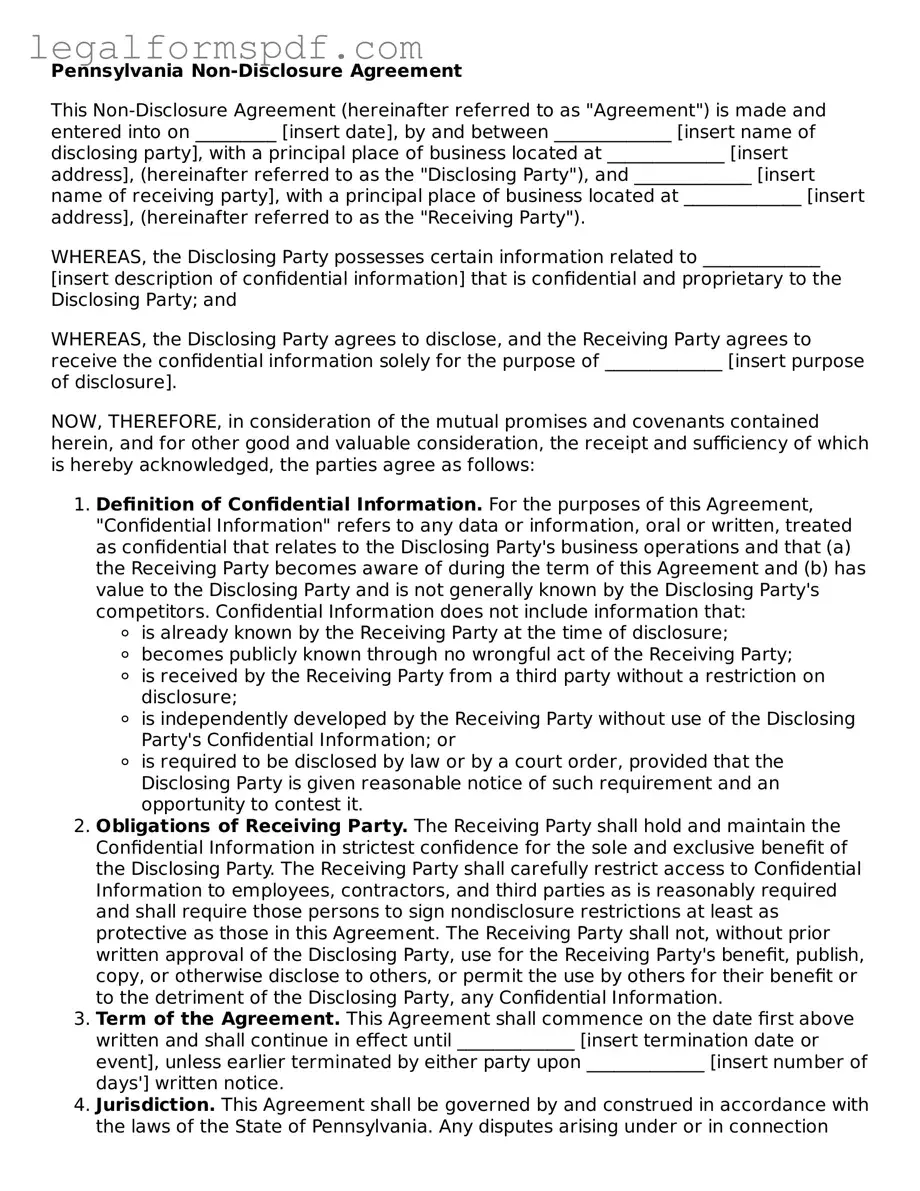A Confidentiality Agreement is one document similar to a Pennsylvania Non-disclosure Agreement (NDA) form. Both are designed to protect private information from being disclosed to unauthorized individuals. They typically include terms that limit the use of the information shared and specify penalties for breaches. Whereas NDAs can be unilateral or bilateral, Confidentiality Agreements are often used in a wider array of contexts, including among employees, consultants, and businesses.
An Employment Contract is another document that shares similarities with NDAs, particularly in sections that deal with confidentiality. Such contracts may incorporate clauses that require employees to keep business operations, client information, and trade secrets confidential during and after their tenure. The purpose of these clauses is to safeguard the employer's proprietary information, akin to the aim of NDAs but within the scope of an employment relationship.
A Non-compete Agreement closely aligns with the objectives of an NDA by restricting parties involved from entering into competition in specified markets for a certain period. However, it differs because it primarily focuses on preventing competition rather than the disclosure of information. Like NDAs, these agreements are common in employment and business sale contexts, ensuring business owners protect their interests.
Intellectual Property (IP) Assignment Agreements share the trait of protecting sensitive information with NDAs, but their purpose is to transfer ownership of intellectual property rights from the creator (or current owner) to another party. While NDAs seek to restrict the disclosure of information, IP assignments ensure the legal ownership and rights to use, sell, or modify intellectual property are clearly defined and legally transferred.
A Proprietary Information Agreement, similar to an NDA, is aimed at preventing the unauthorized disclosure of sensitive information. This type of agreement is particularly focused on protecting intellectual property and proprietary business information, ensuring that those who have access to it are legally bound to secrecy. It is often used when disclosing inventions, unique business methods, or technical know-how.
Business Sale Agreements often contain confidentiality clauses akin to those in NDAs. These clauses are crucial in the context of selling a business, as they protect sensitive business information that is disclosed during the sale process. For instance, financial records, customer lists, and business strategies are safeguarded against being shared with unauthorized parties, competing businesses, or the public.
Data Protection Agreements, while broader in scope, include elements that overlap with NDAs in terms of safeguarding information. These agreements are focused on complying with privacy laws and protecting personal data, but they also include provisions regarding the confidentiality of the data being handled, ensuring that personal and sensitive information is not wrongly disclosed or misused.
A Consultant Agreement, especially when it includes confidentiality clauses, resembles an NDA. These agreements are used when hiring consultants, outlining the terms of the consultant's work, including the protection of any sensitive information they may access while providing their services. It serves to prevent the disclosure of confidential information to protect the client's business interests.
Mutual NDAs are a specific type of Non-disclosure Agreement designed for situations where both parties share confidential information with each other. They are similar to standard NDAs but are bilateral, meaning that both sides agree not to disclose the other's confidential information. This is particularly useful in partnerships, joint ventures, or collaborations where mutual exchange of sensitive information is necessary.
Lastly, a Vendor Agreement may include sections that reflect those in an NDA, particularly when there is a need to protect sensitive information shared with or by the vendor. Such agreements not only outline the terms of service, delivery, and payment but also ensure that any proprietary information, data, or business secrets disclosed during the course of the business relationship remain confidential.
